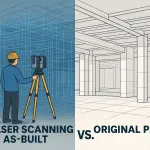Before translating any data, it is essential to establish the ins and outs of digital twin capabilities. The key foundations of any smart city touch on energy, data, and communications.
In addition to collecting data on the internal conditions of a building, its paramount to analyze data on activity between buildings. Air quality and temperature are not enough. Through 3D laser scanning services and artificial intelligence, prioritizing data and optimizing services will be easier. You can easily leverage information from the tourism sector. Through it, you can establish the movement of people.
The main objective is physical infrastructure and not so much how humans interact with the same buildings. You can easily establish what people do but not the reason behind it. You can’t also predict their interaction with passive infrastructure from 3D scanning.
Government leaders must broaden their data scope to capture emotional data. This will help in understanding why people do the things they do. Experts should combine social media, algorithms, good data, and movement to establish emotional data.
Putting 3D Laser Scanning Services To Good Use
3D laser scanning services can easily determine real-time data compared to the past, where they could only capture ambient data. This is critical for a functioning digital twin. The current 3D laser scanning services technology allows the collection of large amounts of data to improve analytics and results.
Therefore, government leaders need to allow data federation to improve analysis and decision-making behind the functionality of digital twins. Currently, smart cities are looking into digital twins to improve their operations. However, their limited knowledge of 3D laser scans is posing a challenge.
Identifying a city’s needs and the potential impact of digital twin technology is the first step to finding a solution. For instance, the Orlando Economic Partnership relies on 3D laser scanning services technology to establish economic development. The partnership involves Lake, Orange, Brevard, Osceola, Polk, Seminole, and Volusia Counties.
Together with Unity, municipal leaders worked to provide a 3D map of the Orlando region. They relied on 3D scanning services to obtain data from the public and private sectors. Through the map, decision-makers can determine economic plans that affect business development and infrastructure. The software development company ensured that the digital twin could be accessed using a headset.
In the last decade, there have been mass improvements when it comes to data. Cities today can control and add to datasets as required using multiple solution providers. Digital twin technology now cuts across different functionality, not just asset management and analytics. It is essential in the decision-making process of leaders.







